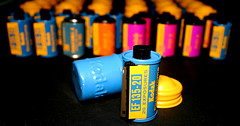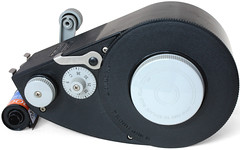35mm film
| ||
| ||
| ||
|
For 35mm cameras, see the Category: 35mm film.
The 35mm format for film was first developed on an experimental scale in Thomas A. Edison's laboratory more than 120 years ago. Edison's associate William Dickson created devices for photographing and viewing moving images on film loops 35mm wide, for which Edison filed a patent in 1891.[1] This width originated by slitting 2.75" wide film rolls in half, and adding perforations. These rolls were supplied by the Eastman Dry Plate and film Company in Rochester, NY; however, it took several years for 35mm movie film to become a regular Kodak product.
Once cine film became widely available, it did not take long for inventors to imagine 35mm still-picture cameras which might be more easily portable than the common large-format plate cameras of the time.[2] Although the first design was patented as early as 1908, it is generally accepted that the first commercially available 35mm camera was the 1913 Tourist Multiple, by the New Ideas Mfg. Co. of New York. This camera ran the film vertically and exposed the standard 18x24 cine frame size (equaling four sprocket holes per frame). This was soon followed by the Simplex, from New York's Multi-Speed Shutter Co., a camera which permitted a choice of either the cine frame size or the "double" frame 24 x 36mm format.
However the camera which brought the 24 x 36mm image format into much greater prominence was the Leica. Oskar Barnack built his prototype Ur-Leica in 1913 and had it patented; but his employer Ernst Leitz only began series production with the Leica A in 1925. The Leica was followed by the Zeiss Contax in 1932, as well as by less expensive cameras such as the Argus A which brought 35mm shooting to a larger market that could not afford the top-quality German models.
The earliest 35mm cameras used cine film bought in bulk and loaded into the cameras in the dark room; but Leitz introduced a film cassette which could be loaded with 1.6 meters of film in the darkroom, which then could be loaded into the camera in daylight when required. Several photographic suppliers made such daylight cassettes for the user to load from bulk. By the early 1930s film manufacturers also supplied film in disposable cassettes, and in 1934 Kodak created an industry standard by introducing the now-ubiquitous 135 format disposable cartridge along with their Retina cameras. Today's 135 cassettes typically have enough film for 12, 24 or 36 frames (of standard 24 x 36mm size) although 20-exposure rolls were once common. The 135 format became by far the most widely used photographic medium until the emergence of the digital camera.
There were other, rival daylight-loading systems, but most of these were minority formats compared to 135. The most successful was the Agfa Karat system, which was introduced for the Agfa Karat cameras in 1936, and was produced until 1963. In 1964 Agfa introduced a 35mm cartridge system, called Rapid, to compete with 126 cartridges. The most recent, and likely last, rival to 135 was APS - which perhaps would have gained wider adoption, but for the rise of digital cameras.
Bulk backs are available for some cameras, aimed at professional use, which allow the photographer to use 100-foot lengths of film at a time, minimizing the inconvenience of having to reload the camera and miss a shot. These were used by some sports photographers, but the digital revolution has largely made bulk backs obsolete.
The frugal photographer can still buy 35mm film in 100-foot lengths and spool his own cassettes. This involves putting the roll of film into a bulk loader in complete darkness. Reloadable cassettes are then filled with film using a crank on the loader. The film is then cut and a leader cut into the tail of the loaded cassette. All this can be done in daylight, hence the loaders are called "daylight loaders".
"Miniature format"
In contrast to the plate and roll-film cameras of the early 20th century, 35mm was regarded as a "miniature format." The term is often seen in advertising and other photographic writings from the era (such as the US magazine title Minicam). As the quality of film stocks improved, there was a growing acceptance of 35mm for professional work; so by the 1960s the term "miniature" had essentially fallen out of use.
Notes
- ↑ History of Edison Motion Pictures at the Library of Congress American Memory Edison Project
- ↑ Early 35mm cameras by Massimo Bertacchi



